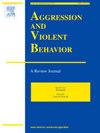The unusual suspects: A systematic search for the molecular and cellular correlates of human aggression
IF 3.4
2区 心理学
Q1 CRIMINOLOGY & PENOLOGY
引用次数: 0
Abstract
Decades of research have uncovered several molecules and cell types (i.e., biomolecules) associated with aggression, violence, and hostility (AVH). In this systematic review, we aimed to identify which of these biomolecules have been predominantly studied in relation to AVH in human adults, and to obtain a general sense of the direction of the effects reported for each identified biomolecule. Eighty-one studies (out of 2914 initial abstracts) were included in the review, totaling 198 effects and 29,565 participants. Hormones, particularly testosterone and cortisol, were by far the most studied biomolecules (57.58 %), followed by cytokines (14.14 %), proteins (9.09 %), and neurotransmitters (4.55 %). Out of all extracted statistical effects, 15.1 % reported a negative association, 45.5 % reported no association, and 39.4 % reported a positive association between AVH and the biomolecules, although this pattern varied substantially for individual biomolecules. We also identified some research on biomolecules pertaining to the immune system, which could turn out to play crucial roles in advancing our understanding of AVH. These quantitative insights into the current state of biochemical research on AVH in human adults provide a basis for shaping a broader and more integrative research agenda for studying AVH.
不寻常的嫌疑人系统探寻人类攻击行为的分子和细胞相关因素
数十年的研究发现了与攻击、暴力和敌意(AVH)相关的几种分子和细胞类型(即生物分子)。在这篇系统性综述中,我们旨在确定这些生物分子中哪些与人类成年人的攻击性、暴力和敌意有关,并对已确定的每种生物分子的影响方向有一个大致的了解。有 81 项研究(2914 份初步摘要中的 81 项)被纳入综述,共涉及 198 种效应和 29,565 名参与者。荷尔蒙,尤其是睾酮和皮质醇,是迄今为止研究最多的生物大分子(57.58%),其次是细胞因子(14.14%)、蛋白质(9.09%)和神经递质(4.55%)。在所有提取的统计效应中,15.1% 的报告称 AVH 与生物大分子之间存在负相关,45.5% 的报告称两者之间没有关联,39.4% 的报告称两者之间存在正相关,但这一模式在单个生物大分子之间存在很大差异。我们还发现了一些与免疫系统有关的生物大分子研究,它们可能会在促进我们对 AVH 的了解方面发挥关键作用。这些对人类成人 AVH 生物化学研究现状的定量分析,为制定更广泛、更综合的 AVH 研究议程奠定了基础。
本文章由计算机程序翻译,如有差异,请以英文原文为准。
求助全文
约1分钟内获得全文
求助全文
来源期刊

Aggression and Violent Behavior
Multiple-
CiteScore
7.50
自引率
4.30%
发文量
63
期刊介绍:
Aggression and Violent Behavior, A Review Journal is a multidisciplinary journal that publishes substantive and integrative reviews, as well as summary reports of innovative ongoing clinical research programs on a wide range of topics germane to the field of aggression and violent behavior. Papers encompass a large variety of issues, populations, and domains, including homicide (serial, spree, and mass murder: sexual homicide), sexual deviance and assault (rape, serial rape, child molestation, paraphilias), child and youth violence (firesetting, gang violence, juvenile sexual offending), family violence (child physical and sexual abuse, child neglect, incest, spouse and elder abuse), genetic predispositions, and the physiological basis of aggression.
 求助内容:
求助内容: 应助结果提醒方式:
应助结果提醒方式:


